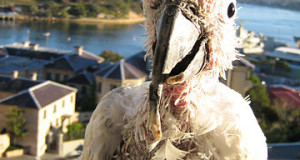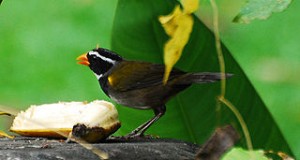 Research conducted at New York’s Cold Spring Harbor Laboratory (Nature: May, 2009) has, for the first time, illustrated the complex interplay of genetics, learning and social situation in the acquisition of birdsong.
Research conducted at New York’s Cold Spring Harbor Laboratory (Nature: May, 2009) has, for the first time, illustrated the complex interplay of genetics, learning and social situation in the acquisition of birdsong.
Learning What Song to Sing
As is true for all birds studied, zebra finches (Taeniopygia guttata) raised in isolation from others of their kind fail to develop the song typically sung by the species.
It was therefore long believed that birds learned species-specific notes by listening to the calls of adults. In fact, zebra finches that are raised by society finch foster parents sing the song of the society finch, not their own, once mature.
The Surprising Influence of Genes
In the Cold Spring Harbor experiment, finches raised in isolation developed odd songs that were not typical of their species, and this song was mimicked by their chicks. However, after 4-5 generations, the typical (natural, wild-type) zebra finch song began to emerge, despite the fact that the birds had never heard this song.
The shocked scientists concluded that the song is stored within the genome, but that several generations must pass before it emerges spontaneously. Under normal circumstances (i.e. where the chicks are raised with exposure to the adult song), learning interacts with genetics to assure that the song is acquired right away.
Future Research Objectives
 Ornithologists are interested in discovering if the same process is at work in other species as well…perhaps even the complex and beautiful song of the nightingale is encoded in each male chick.
Ornithologists are interested in discovering if the same process is at work in other species as well…perhaps even the complex and beautiful song of the nightingale is encoded in each male chick.
This research also is expected to have important implications in the study of human language development, and will hopefully lead to new advances in speech therapy.
Further Reading
The zebra finch is one of our most important laboratory animals, and the story of its entry into the pet trade has some surprising twists and turns. Please see my article The Unknown Side of the Zebra Finch for further information.
A review of this species’ vital role as a laboratory subject is posted at
http://genome.wustl.edu/genome.cgi?GENOME=Taeniopygia%20guttata
NightingGale image referenced from Wikipedia and originally posted by Orchi.
 That Bird Blog – Bird Care and History for Pet Birds
That Bird Blog – Bird Care and History for Pet Birds



i love birds
Hello, Frank Indiviglio here.
Thanks for your interest in our blog. Please keep checking in…I look forward to your future questions and comments.
Enjoy!
Best regards, Frank Indiviglio.